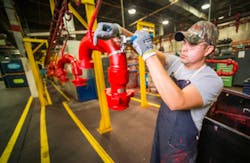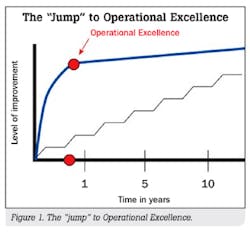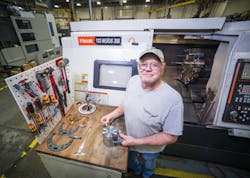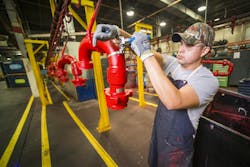Flow control manufacturers typically must deal with complex, highly engineered, high-work content products that can take days, or even weeks, to completely build, depending on their size and complexity. And they must produce a large mix of products capable of meeting a range of customer demands. It is not an easy operation.
Seeking to boost their performance, many flow control manufacturers have attempted to apply lean techniques from the automotive industry to their operations, but there’s a catch … In the automotive industry, demand is fixed over many months and the schedule is leveled. Flow control manufacturers, however, must contend with high variation in demand along with a high mix of products, and wrestle with long lead times from suppliers, complex manufacturing environments, shared resources, and monumental equipment to produce a technical product that fits their customers’ needs.
Some flow control manufacturers have used lean tools to help organize their factories and eliminate waste. While this approach can yield improvements in lead time, efficiency, inventory reduction, and more, even after several years, the results are incremental. Recently, however, a few manufacturers have adopted a new approach to lean that can jump their performance in months, not years (Figure 1).
How? These companies start by changing the way they think about lean. Instead of trying to seek out and eliminate waste with lean tools, which focus on getting better every day (an endless journey), they set a destination for all lean activities. After all, companies that know where they are going will simply get there faster. A good destination for lean or continuous improvement activities is Operational Excellence, as when, “Each and every employee can see the flow of value to the customer, and fix that flow before it breaks down.”SM
Companies who use this approach no longer endlessly seek to eliminate waste; rather, they seek to flow product to the customer by designing value stream flow. And not just any value stream flow, but a self-healing flow where employees who build the product also understand whether delivery to the customer is on time or not, and can take the action needed to ensure the customer gets their product on time—all without management intervention.
The key word here is design. Achieving Operational Excellence in the flow control industry happens by following a specific set of principles and guidelines, not by applying tools or brainstorming.
Designing for OpEx
The goal of Operational Excellence is to achieve a lean flow of product from raw material to the customer that is autonomous; it just works every day without attention from management. This result can be accomplished by creating a production environment in which the employees can fix flow breakdowns before they become catastrophic and negatively impact the customer.
While most companies strive to create value stream flow through their factories to eliminate waste and improve efficiency, the more progressive companies who have set a destination of Operational Excellence create flow simply so they can see when flow stops. For them, creating flow is not the goal. Instead, knowing what to do when flow stops (and it will) is.
To design flow in the operation, there is a process to follow, similar to how a blueprint provides a schematic to follow when creating a bridge or building. Operational Excellence is achieved by following eight principles that are completed in sequence and can be adapted to many different production and work environments. The result will be a comprehensive design of value stream flow from end-to-end in all areas of the business. The eight principles of Operational Excellence are as follows:
1. Design lean value streams
2. Make lean value streams flow
3. Make flow visual
4. Create standard work for flow
5. Make abnormal flow visual
6. Create standard work for abnormal flow
7. Have employees in the flow improve the flow
8. Perform offense activities
The first principle is where many companies can get frustrated. However, it is important to remember that designing lean value streams does not mean a team will map the current state and then brainstorm or kaizen-out the waste that is identified. Instead, value stream flow is designed using guidelines that create self-healing flow, and then those guidelines are applied to implement the self-healing flow. Brainstorming never enters the picture, and that is a significant difference, one that enables companies to “jump” their performance rapidly to Operational Excellence.
Operational Excellence at FMC Technologies
FMC Technologies has 30 production facilities in 17 countries and provides technology solutions for the energy industry via products such as subsea production and processing systems, surface wellhead systems, high-pressure fluid control equipment, measurement solutions, and marine loading systems for the oil and gas industry.
At FMC Technologies’ 310,000-square-foot manufacturing facility in Stephenville, Texas, a variety of equipment is produced that serves customers worldwide, including articulating frac arms, manifold trailers, plunger and piston pumps, well service pumps, compact valves, and measuring instruments.
Three years ago, FMC Technologies’ Fluid Controls business recognized that business was growing rapidly enough to warrant a re-examination of its production lines in order to meet the expected growth in demand over the next five years. “When the market turns in this business, it can turn very rapidly,” said Chris Moore, manufacturing manager of the Stephenville facility, who noted how important it is to be able to increase output quickly when faced with changing business conditions.
“What we like about [the Operational Excellence approach] is that it’s not about a slow process of continuous improvement, where you make incremental changes on a day-by-day basis,” said Dan Fortune, the Global Business excellence manager for FMC Technologies’ Global Product Lines. “The key is to start by planning significant improvements, which are designed to accelerate how quickly you can achieve your goals.” The rapid growth FMC Technologies was anticipating made pursuing Operational Excellence an attractive option.
With a heavy focus on the first principle of Operational Excellence (design lean value streams), employees from all areas of the Stephenville plant worked to create current state maps of their operation. Then, by applying a series of design guidelines used to create value stream flow, the teams designed future states for how their areas would operate once implementation was complete.
Once the basic value stream design was complete, the team learned more advanced techniques for their high mix, demand-changing environment. These included courses in mixed model production and flow through shared resources, which were also adopted at the Stephenville plant. The focus, however, was not simply on creating end-to-end flow, but on creating self-healing flow that the employees could fix on their own without management intervention.
“The ability to create that “self-healing” flow minimizes the amount of supervision required for employees to resolve problems,” said Fortune. “That allows management to focus on growing the business, instead of expending their energy in running it.”
Once each value stream was designed, the team at FMC Technologies’ Stephenville plant determined that the best way to begin the implementation phase was to create a “model” value stream. This approach involved creating a working value stream within the Stephenville facility that operated according to the principles of Operational Excellence, specifically, creating visual flow to monitor the replenishment of kit components, plugs, rings, and segments in the plug valve area.
The results have been nothing short of transformative:
Within one year, the plug valve area at the Stephenville facility saw a 38 percent increase in output, with no additional production resources added;
- Long sweep components saw a 22 percent increase in productivity;
- Overall plant productivity increased 27 percent; and
- Scrap costs per earned hour fell by more than 50 percent.
“The next step is to expand these processes across the rest of our product lines and embed this cultural change throughout the entire business,” said Cliff Pettit, product line manager of Flowline.
Beyond Stephenville: Taking Operational Excellence Worldwide
Not only does FMC Technologies plan to bring Operational Excellence to other areas of the Stephenville facility, but also efforts are ongoing to spread Operational Excellence throughout the entire organization globally.
“The Controls and Data Management product line in Kongsberg, Norway, has already seen great success with Operational Excellence,” said Fortune, “and Well Completion Systems is using the same philosophy with their Modular Build projects in Rio de Janeiro, Brazil, Dunfermline, Scotland, Nusajaya, Malaysia, and Houston, Texas.”
By applying the same principles and methodology of Operational Excellence that worked so well in Stephenville, FMC Technologies will continue to drive top- and bottom-line business growth throughout its organization and position itself as a market leader well into the future.
Kevin Duggan is a renowned expert in applying advanced lean techniques to achieve Operational Excellence and the author of three books on the subject: Design for Operational Excellence: A Breakthrough Strategy for Business Growth, Creating Mixed Model Value Streams, and The Office That Grows Your Business – Achieving Operational Excellence in Your Business Processes. As the president of Duggan Associates, an international training and advisory firm, and founder of the Institute for Operational Excellence, the leading educational center on Operational Excellence, Duggan has formally educated and assisted many major corporations worldwide over the past 12 years. A recognized authority on Operational Excellence, he has contributed to many publications, is a frequent speaker at both private and public conferences, and lectures graduate students in business at colleges throughout the United States. He can be reached at [email protected] or 401 667-7299.





